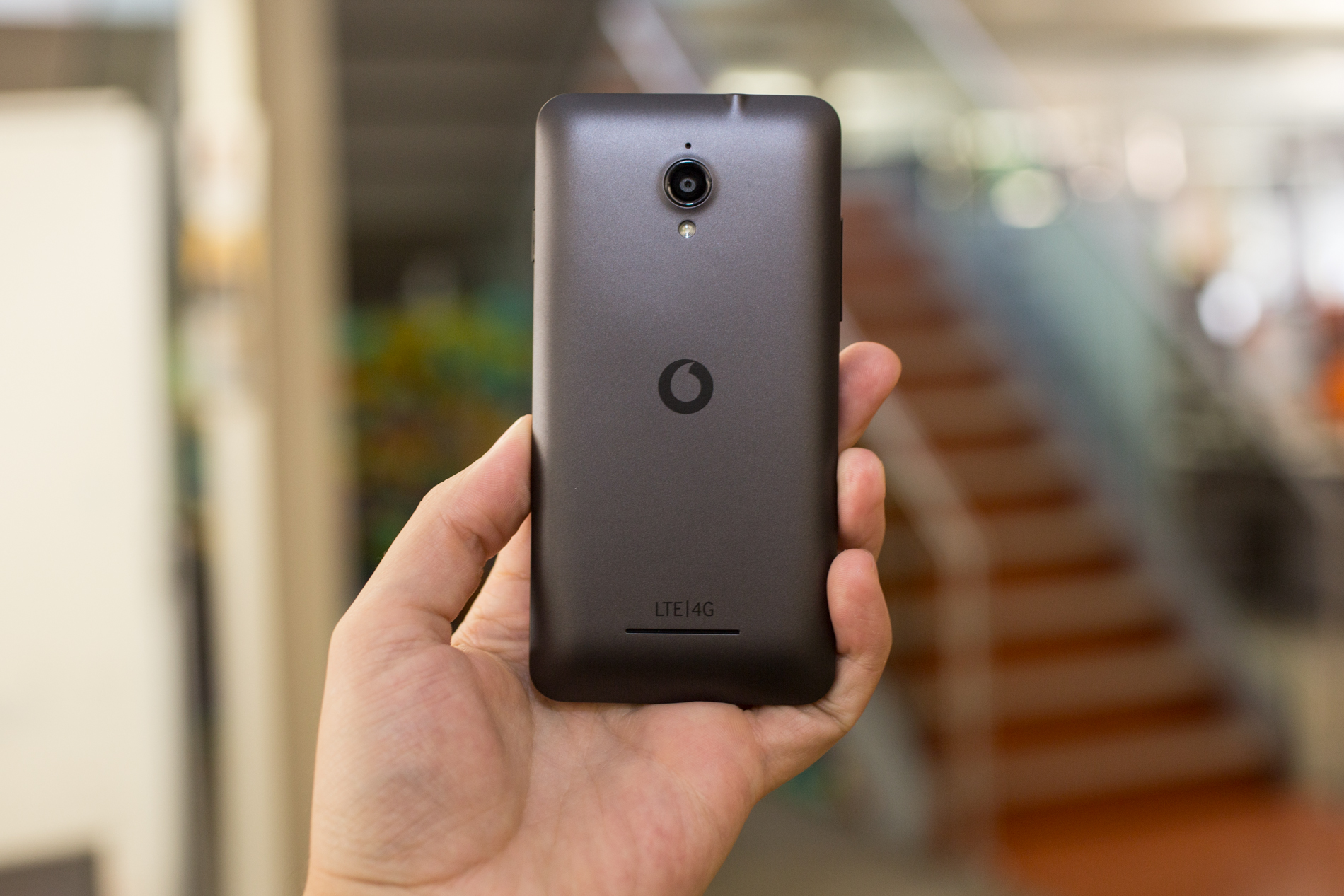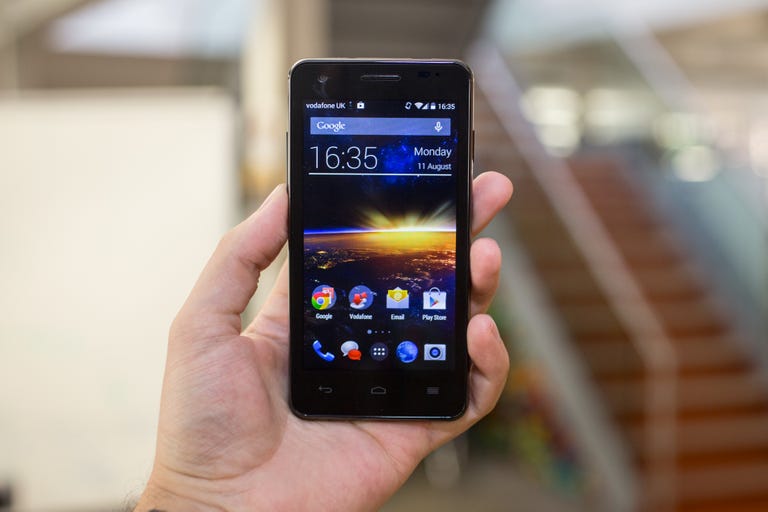 Why You Can Trust CNET
Why You Can Trust CNET Vodafone Smart 4 Turbo review: A cheap 4G Android phone that cuts too many corners
The Vodafone Smart 4 Turbo is certainly an inexpensive way of getting 4G, but it makes too many compromises elsewhere for it to be a good buy.
Budget smartphones have changed dramatically over the past couple of years, with technology once found only inside the most expensive mobiles now available on bog-standard, entry-level devices.
The Good
The Bad
The Bottom Line
The Vodafone Smart 4 Turbo is just such a device, boasting a 4.5-inch display, a quad-core processor, 4G LTE and Android KitKat software. You can pick the Turbo up now only on Vodafone for £135 on pay as you go, or free on Vodafone's 4G plans from £26.50 per month.
Oddly, you can't buy the Turbo on Vodafone's online store. Instead, you'll have to march down to one of its high street shops like it's 2004. Still, at least you can grab a coffee on the way.
Design
There's no escaping the fact that the Turbo is a budget phone. Its back is a single expanse of dark grey, rubberised plastic that's very plain. The front is a single piece of glass, broken only by the speaker grille, and with only the touch-sensitive navigation keys providing any visual interest.
At 10.4mm thick, it's pretty chunky. Together with the wide bezel surrounding the display, the Turbo is a thoroughly uninspiring piece of kit all round. It certainly won't appeal to the fashion-conscious among you.

Its beefy body does at least feel quite sturdy. There's little flex from the chassis and the back panel's rubberised coating can take attacks from the keys and coins in your pocket without showing up every single scratch.
The phone comes with only 4GB of built-in storage, which you'll blow through extremely quickly -- particularly if you store your music locally. Some games too, like the popular racer Asphalt 8, can take up over 1GB of space. Although you're unlikely to go for this phone if you're a dedicated app addict, I'd still recommend splashing out on a cheap microSD card to store photos from the camera, reserving the limited on-board space for apps.
You can move some apps to an SD card once you've run out of built-in storage, but in my own tests, when I moved a large app across it didn't seem to free up any space in the phone. It appears as though it's copying the app across, keeping both sets of install files, meaning there's no actual benefit in moving the app in the first place. This could just be a bug, but it's going to be a problem if you're keen on downloading apps and games.
Display
The 4.5-inch display has an 854x480-pixel resolution -- right at the bottom of what I'd expect to see, even on a budget phone. It results in a disappointing density of 217 pixels per inch. By comparison, the Motorola Moto G 's 4.5-inch screen has a 720p resolution, giving it a much sharper pixel density of 326ppi.
The Turbo's display, then, is underwhelming. Icon edges and text in menus and in Web pages are far from sharp and lack the same crisp, easy to read presentation that you find on higher resolution screens like the Moto G's. It's not particularly bright either, meaning it's not great at countering reflections -- I was often left staring at my own face when swiping around.
Its colours are acceptable, although I've seen better on similarly priced phones, and it doesn't have good viewing angles either -- it really doesn't get anything right. It's exactly the sort of screen you should be afraid of getting when buying a budget phone.
Sure, it can display the basics like the phone dialler and messaging app, but it doesn't make anything look good and when you can get a fantastic display on the Moto G for similar money, there's really no excuse for such a miserable screen.
Android software
It's running on the fairly recent Android 4.4.2 KitKat. It's not the most bang up to date version -- that honour goes to 4.4.4 KitKat -- but it's more recent than 4.3 Jelly Bean, which still crops up on budget phones from time to time, so I'm reasonably satisfied.
Unlike Samsung, HTC's and Sony's Android phones, which have a heavily customised version of Android, the Turbo's software is almost stock Android.
That's a good thing for two reasons. Firstly, it means that it's easy to get to grips with, even if you're not well-versed with Android. It hasn't complicated things by forcing you to use proprietary image galleries or confusing you with multiple Web browsers or email clients. It also means it's less demanding of the processor, so in theory you'll have a swifter experience than if it was crammed with bloatware.
There are a few things preloaded, including a tips and tricks app for new Android users, and apps to track your phone usage. None are exactly crucial and they can be uninstalled, so feel free to completely clear out anything you don't want when you first get it home.
Processor and battery performance
The phone is powered by a 1.2GHz quad-core processor, which is respectable, if far from the kind of brutal power you see in flagships such as the Galaxy S5 , Sony Xperia Z2 or HTC One M8 .
Swiping around the interface seemed reasonably swift, however, with no real lag when pulling down the notification bar or diving into the app tray.
It handles simple stuff like Facebook, Twitter and Instagram without any hassle and streamed Netflix fairly well too. Asphalt 8 played reasonably well, although low-resolution displays don't take as much processing power to run, so I'd have been surprised if it struggled too much.
It's running on a 1,880mAh battery, which doesn't put up much of a fight. From full, the power level had dropped to only 56 percent remaining after just 2 hours of video streaming, which is below average for this test.
With careful use you might be able to squeeze a day out it, but if you find yourself browsing the Web, using maps or streaming music, you can expect the battery to have drained away before the day is done -- particularly if you stream using 4G which is more power-intensive than 3G.
Camera
Around the back is a 5-megapixel camera. A meagre 5 million pixels might not seem like much when you compare it to the whopping 20-megapixel sensor in the Xperia Z2, but it's about what you should expect for this price.
Vodafone Smart 4 Turbo camera test
Although the results from the camera are far worse than the efforts of pricier phones, they're adequate for a little Instagram fun. On my first shot of these toys, exposure was decent and there's enough detail in the image to make it look reasonably crisp at full screen. The colours are rather cold though.
Vodafone Smart 4 Turbo camera test
Like nearly all budget smartphones, the Turbo's camera struggled in lower light. In this shot of our office, there's a lot of image noise in the shadowy areas and there's less clarity in the edges of the chairs and pillars. It's certainly no worse than what I've seen on other budget phones, however, and it's really all you can expect from such a cheap device. Keep to well-lit areas and you should be able to get snaps good enough for Facebook updates.
Conclusion
Although the Vodafone Smart 4 Turbo has an affordable price tag, its awful display, unimpressive battery life and dreary design mean it's still not a good buy. If you're not tied to Vodafone, you could opt for EE's own-brand 4G Kestrel phone , which offers a much more satisfying experience overall for £99 on pay as you go. Or you could splash a little more cash and get the superb Motorola Moto G, which now has 4G too.


